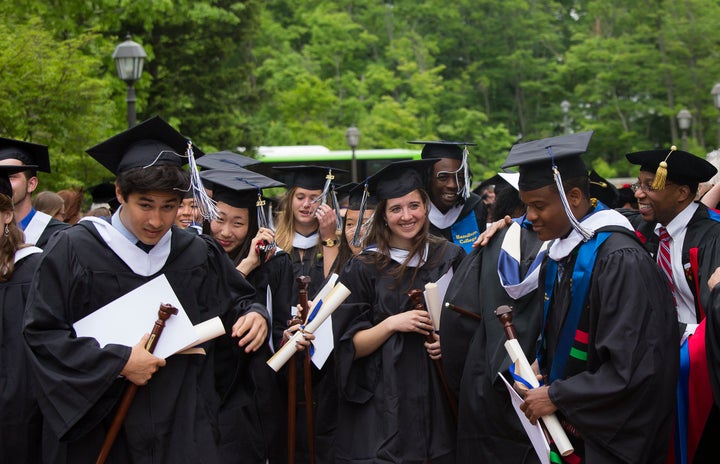
CLINTON, N.Y. — There’s a stone patio in front of the admissions building at Hamilton College, a gift from members of the Class of 2014 to commemorate -- of all things -- an obscure acceptance policy that benefitted many of them.
That policy, adopted in 2010, formalized something called “need-blind” admissions. No longer would the elite, private college consider how much money an applicant’s family made when making acceptance decisions. The students decided that memorializing this in stone would make it difficult for Hamilton to go back on its commitment.
It may seem surprising -- even in the secretive world of college admissions -- that applicants to most schools are, in fact, judged not only by their academic ability and promise, but also on their financial situations. After all, said Nick Gustaitis, a Hamilton senior, if you work hard enough, and are smart enough, you’re supposed to be able to accomplish anything.
“This is something I think most people have no idea about -- that your income affects whether or not your kid gets into college,” said Gustaitis, who comes from what he describes as a blue-collar family without much money.
Hamilton admissions director Monica Inzer said she was surprised by this, too, when she arrived at the campus of stately stone buildings on a hill overlooking the Oriskany and Mohawk Valleys of Central New York, and was put to work considering applicants.
“They opened up a folder and said, ‘Here’s Johnny, and here’s his SAT scores and here’s his GPA and here’s his [financial] need,” she recalled.
“The hardest part of my job was deciding who not to take,” Inzer said. “I didn’t like that some of those were because of money.”
Hamilton is one of the more expensive private colleges in the U.S. Tuition, room and board cost more than $60,000 a year. Prior to the 2010 policy change, this high price tag posed a special challenge for admissions officers, who were told to admit not just the best students, but the best students who they deemed also had the means to pay the bill.
The rationale for this seemingly exclusionary approach had everything to do with maintaining Hamilton’s sterling reputation as an elite college. Accepting lower-income students who couldn’t afford the school could damage its so-called yield rate -- the proportion of accepted students who enroll.
Colleges with high yield rates use the measure as a recruiting tool. It indicates, they say, that elite students are clamoring to attend their institutions. Ivy League institutions and Stanford in particular announce their yield rates as proof of their appeal; Stanford’s this year was a record 81 percent, Yale’s about 70 percent, Harvard’s 81 percent and Princeton’s 69 percent.
Hamilton, like most other colleges, also dished out financial aid to higher-income students as an extra incentive to enroll. This assistance is called merit aid, and the proportion of students who receive it has nearly doubled to 44 percent at private, nonprofit colleges and universities since 1995, the U.S. Department of Education reports.
Offering financial aid to higher-income students, and purposely weeding out lower-income applicants, has the effect of ensuring a disproportionately wealthy student body. An analysis of federal education data by The Hechinger Report and The Huffington Post found that colleges are becoming more and more segregated by wealth.
Inzer said that in 3 to 5 percent of all acceptance decisions at Hamilton, students were either turned down because they couldn’t afford to pay, or offered the chance to attend because they could.
“We didn’t have enough money to admit the kids we wanted to admit and we were giving money to kids who didn’t need it,” she said.
Yet that’s what most other colleges and universities do, particularly highly selective and expensive private nonprofits. They describe this approach as “need-aware admissions.” George Washington University, for instance, said in 2013 that it puts hundreds of applicants on its waiting list because they can’t afford to pay the $66,660 annual cost of attendance.
Hamilton dropped merit aid in 2008, in the midst of the economic downturn, because administrators like Inzer thought it was unfair, and because the college couldn’t afford to spend as much as wealthier rivals in the battle for students.
The college’s board of trustees then convened to consider how it could distinguish itself in a crowded field of similar small, selective northeastern liberal-arts institutions. During a six-hour meeting, Inzer suggested dropping altogether the policy of reviewing applicants’ financial circumstances.
Among the reasons leaders of the college cite for that decision is its origins as a seminary begun by Presbyterian missionaries. But this shift, too, was as strategic as it was philosophical.
That’s because the mix of high school graduates headed for the likes of Hamilton and other American colleges is changing fast. The U.S. Department of Education projects that the number of college students who are Hispanic will jump by 42 percent and the number who are black by 25 percent through 2021, while the number who are white will inch up only 4 percent. And many of these new students will be children of lower-income parents who did not go to college.
“Most companies don’t know who their customers will be in five years, but I do, because they’re in the seventh grade,” said Inzer, herself the first in her family to earn a degree.
But though it wanted to stop considering income as a factor in decisions, the college wasn’t prepared to see its yield, or its enrollment, drop as a result. To avoid this possibility, Hamilton decided it would have to find enough financial aid so that, once it admitted lower-income students, it could help them afford the bill.
At that meeting at which board members agreed to drop financial considerations from admission decisions, six of the trustees pledged $500,000 each toward this goal. The college has since raised $40 million for the initiative and has begun another fundraising campaign to support the policy, which was put in place in 2010.
Hamilton is now officially need-blind, which means it doesn’t consider an applicant’s financial need in its admissions decisions, and helps them pay for college with a combination of financial aid and loans. In the years since it adopted the change, the proportion of freshmen who are low income has eked up slowly, from 10 percent to 14 percent through 2013, government data show. Inzer said the university’s calculations show the population of poor students has increased to 18 percent. (Low-income is defined as eligible for federal Pell grants that generally go to families with incomes of $40,000 a year or less).
The proportion of Hamilton students who are nonwhite is up from 13 percent to about 25 percent, the college says. (This boost hasn’t stopped the kinds of protests that have occurred on other campuses. At Hamilton, an anonymous group called “the Movement” has called for more racial diversity among faculty and made other demands.)
In opting for a need-blind admissions process, Hamilton has bucked a national trend. Just 41 colleges and universities in the U.S. follow this approach. Tufts and Wesleyan both abandoned need-blind in 2008, and Case Western is considering also making the change.
When Moody’s downgraded its bond rating for Haverford College in October, one of the reasons it cited was the high cost of its need-blind admissions policy. Haverford declined to respond to questions about this, or its future plans.
And while most Hamilton students, alumni and faculty liked the idea, some parents didn’t, said Joan Hinde Stewart, president of Hamilton and the daughter of a Brooklyn pipefitter who also was the first in her family to go to college. Parents of high-achieving students have come to expect merit aid, for instance, she said, and know that other schools will give it to them.
Nor does everyone who believes in boosting access for low-income students think need-blind admission is the answer. Even if admissions officers don’t know a student’s family income, there are plenty of other clues in applications that can tell them whether someone can contribute to the bottom line, or will need a big outlay of financial aid. An applicant’s address, caliber of high school, courses taken and the person who wrote letters of recommendation can reveal whether the student comes from a wealthy background, or an impoverished one.
“All of those things conspire against a kid who doesn’t have a college counselor who knows him, who doesn’t know you have to proof the [admissions] essay seven times, doesn’t know he has to get on the track for AP courses,” said Jon Boeckenstedt, associate vice president of enrollment management at DePaul University in Chicago, which is need blind. “Every single factor in that file screams privilege or wealth or poverty or lack of opportunity.”
Thinking that a need-blind admissions policy actually doesn’t consider a student’s financial status in some way “is self-delusional,” he said.
What top colleges really must do to close the wealth gap is reach out to students who don’t apply in the first place, said Adam Falk, the president of Williams College in Williamstown, Massachusetts. Williams teams up with a nonprofit called QuestBridge to find high-achieving low-income prospective applicants to its campus, and flies them there for visits. Almost 20 percent of Williams students are low income..
The idea of need-blind admission “fits nicely on a bumper sticker,” Falk said. But turning off your information about the financial need of students isn’t good enough. You have to go out there and find students. That means going into communities with high financial need and actively recruiting there.”
It also means supporting students from those places when they show up, Falk said.
Hamilton found it needed to set up a fund for financial emergencies for students so poor they couldn’t afford to pay for such things as graduate-school admission tests or visits to a dentist. It has another fund to subsidize low-income students who take unpaid summer internships.
“Hamilton doesn’t pretend that we’ve eliminated socioeconomic inequality,” said Brian Sobotko, another senior there, who said he was able to enroll only because he got enough financial aid. “One little college at the top of a hill in upstate New York won’t change the world. But the fact that we have this is a step forward.”
This story was produced by The Hechinger Report, a nonprofit, independent news organization focused on inequality and innovation in education, in collaboration with the Huffington Post.
